#ego and atman
Explore tagged Tumblr posts
Text
Balancing Ego and Atman: A Path to Inner Harmony
In the journey of personal growth and spiritual awakening, one of the most profound challenges we face is understanding the relationship between our ego and Atman. The ego, often seen as the source of our individual identity, is the part of us that interacts with the world, makes decisions, and defines who we think we are. Yet, beneath the surface, there exists a deeper, more authentic aspect of…

View On WordPress
#Atman#balancing ego#ego and atman#ego integration#heart sutra#infinite self#Inner peace#inner wisdom#meditation#mindfulness practice#nondual teachings#personal growth#psychology and spirituality#Self-awareness#self-compassion#Spiritual Awakening#spiritual journey#transcendence#true Self#wisdom of Atman
0 notes
Text
I WAS FRAMED!
“Enframing means the gathering together of that setting-upon which sets upon man, i.e., challenges him forth, to reveal the real, in the mode of ordering, as standing-reserve. Enframing means that way of revealing which holds sway in the essence of modern technology and which is itself nothing technological.” —Philosopher Martin Heidegger Got that? Probably not, read it again. The notoriously…

View On WordPress
#alienation#art#Arthur Schopenhauer#artists#atman#attachment style#capitalism#dasein#ego#enframing#exchange value#happiness#heidegger#karl marx#lot in life#pair-bonding#peer-bonding#socialization#technology#will#working for a living
2 notes
·
View notes
Text
The Tapestry of Reality
Synchronicity and the Illusion of SeparatenessIn the dance of existence, our perceptions often lead us to believe in the solidity and separateness of things. The term “Maya,” derived from ancient philosophical traditions, refers to the illusory nature of the world. It’s a veil that covers the true essence of reality, suggesting that what we experience is not exactly what it seems.The concept of…
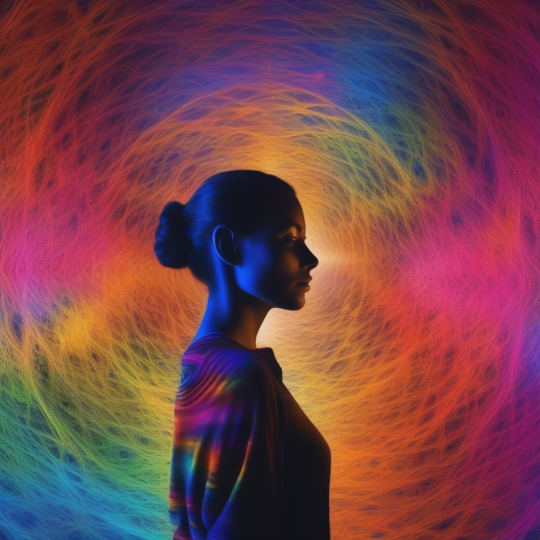
View On WordPress
2 notes
·
View notes
Text
अंतःकरणातील दिव्यता प्रकटते तेव्हा…
तेथ नक्षत्र जैसें उलंडलें । कीं सूर्याचें आसन मोडलें ।तेजाचें बीज वि��ूढलें । अंकुरेंशीं ।। २२६ ।। ज्ञानेश्वरी अध्याय सहावा ओवीचा अर्थ – त्या ठिकाणी जसें नक्षत्र तुटून पडावें अथवा सूर्यानें जसें आपलें आसन सोडून खालीं यावें किंवा प्रकाशरूप बीजासच अंकुर फुटावा. ध्यानस्थितीत, अंतःकरणात असा विलक्षण अनुभव होतो की जणू आकाशातील नक्षत्रं उलथून पडली आहेत, सूर्यच आपलं सिंहासन सोडून खाली आला आहे, आणि…
#atman#awakening#Brahman#consciousness#detachment#divine within#Dnyaneshwari#ego dissolution#enlightenment#inner awakening#inner peace#inner spark#kundalini#meditation#mystical experience#self-realization#silence#Soul#spiritual growth#spiritual insight#spiritual light#stillness#Transcendence#Wisdom#Yoga#अंतःकरण#अंतःज्योती#अंतर्ज्ञान#अंतर्मुखता#अध्यात्म
0 notes
Text

Unleash Your Inner Genius — Discover Your True Self Beyond the Ego
The ego desires a predictable world, yet Life (ٱلْحَىُّ) is beyond the labyrinth of uncertainty. Embrace the unfamiliar, for it is within the nebulous intersection of the known and unknown that true innovation and growth flourish.
Bridge the gaps with creative thought and a curious mind, not fear and doubt. The ego is a component of you, but not the totality. It is a lens through which you perceive the world, but not the world itself.
Cultivate a profound understanding of your authentic self, beyond the limitations of the ego. This will enable you to navigate the quotidian with greater sagacity, empathy, and liberty.
#Ego#Uncertainty#Creativity#Self-awareness#Freedom#Mastery#Empathy#Tasawwuf#Non-Dualism#Atman#Ayn Sof#aainaa-ridtz#sainte communion#aainaa ridtz#voyage#amour#citation du jour#Nafsu#Al Hayy#ٱلْحَىُّ
1 note
·
View note
Text
Sun and the Father-Child Relationship in Vedic Astrology
In Vedic astrology, the Sun (Surya) represents power, authority, government, discipline, ego (self), self-esteem, leadership, the soul (Atman), father, and vitality. The Sun is considered the king among all planets, symbolizing the guiding influence of the father and authority figures in shaping an individual's purpose, confidence, integrity, and self-worth.
A strong and harmonious Sun in the birth chart grants willpower, self-esteem, honor, and a strong moral compass. However, an afflicted Sun—even when strong—can indicate challenges in the father-child relationship, struggles with authority, fluctuating self-esteem (from low to excessive), and difficulties in self-assertion within society.
The 9th house and the father's influence
In Vedic astrology, the 9th house in the Lagna (Rasi) Chart is primarily associated with the father, teachers, and mentors, representing guidance, wisdom, and spiritual blessings. Additionally, the 10th house signifies the father’s career and social status, while the Sun is the natural Karaka (significator) of the father.
The placement of the Sun, its zodiac sign, nakshatra, and its relationship with other planets reveal insights into the father’s personality and the bond shared between father and child.
The Meaning of the Surya Lagna
The Surya Lagna is a chart where the Sun is placed in the 1st house and analyzed as the Lagna ( Ascendant) This chart highlights one’s physical vitality, ego, and the father’s influence on self-perception and authority. It also describes the spiritual lessons of the Atman (soul). A strong and well-placed Sun in the Surya Lagna and the Navamsa Chart suggests a father who instils discipline, confidence, and moral values. However, an afflicted Sun may indicate an absent, authoritarian, or misunderstood paternal figure.
Indications of a positive and supportive father-child relationship
The following planetary combinations suggest a harmonious and guiding presence of the Father:
The 9th house lord placed in a Kendra (1st, 4th, 7th, or 10th house) or Trikona (1st, 5th, or 9th house) strengthens the father’s support and guidance.
Sun in the 11th house and the 11th house lord in Kendra or Trikona houses.
A mutual aspect between the 1st and 9th house lords, particularly if they are friendly planets, indicates a strong father-child bond.
The Sun in Fire signs (Aries, Leo, or Sagittarius) without malefic influences suggest a confident, righteous, and protective father.
Benefic planets like Jupiter or Venus influencing the 9th house promote a nurturing, wise, and moral father.
The 9th house lord in conjunction with benefic planets signifies a father who provides spiritual and ethical guidance.
Sun and Jupiter in the 9th house enhance paternal wisdom and integrity.
The Sun in the 10th house, unafflicted and supported by benefic aspects, indicates a father who is a strong role model and mentor.
Indications of a challenging father-child relationship
Certain planetary placements may indicate difficulties or conflicts in the father-child dynamic:
The 9th house lord in Dusthana houses (6th, 8th, or 12th) suggests paternal challenges:
6th house: The child may perceive the father as overly strict, critical, or a source of hardship and discipline.
8th house: The bond may be marked by secrecy, intense experiences, or sudden changes, including the death of the father in early childhood (if the Sun is in the 8th house).
12th house: The father may be emotionally or physically distant, leading to detachment, lack of support, and guidance.
Malefics (Mars, Rahu, Ketu, Saturn) in the 9th house or aspecting it suggest karmic burdens or challenges with father figures and mentors.
The Sun conjunct Saturn or opposite Saturn can indicate a distant, demanding, or absent father, which often leads to higher responsibility and maturity at a young age.
The Sun in the 12th house suggests an absent or authoritarian father, which can cause low self-esteem and a need to focus on spirituality. This is especially important for overcoming traumas and any psychologically bad influences from a father figure or his lack of presence in a person's life. Acceptance and the ability to let go are very important here.
A debilitated and weakened Sun (Libra and Aquarius) in conjunction with malefic planets may lead to self-confidence issues, authority problems, or lack of paternal support.
A debilitated and unaspected Sun (Libra) in the 4th house - indicates lower vitality, introverted nature. There might be issues with self-esteem and lack of paternal support & care.
Ketu in the 10th house (especially when its dispositor is in conjunction with or aspected by the Sun) can indicate an absent or disengaged father.
Sun + Ketu (conjunction) - similar effect as above. May give lower ego and more inclination towards the spiritual aspects of life.
Sun + Rahu (conjunction) can lead to an ambiguous or complex paternal relationship, which can cause ego issues, emotional distance, obsessions or materialistic influences.
Indications of the father's health
Good health Indicators
A strong and unafflicted Sun (Leo or exalted in Aries) ensures father's vitality and longevity.
Sun in the 11th house (Upachaya house) improves overall health and well-being over the years.
The 9th house lord placed in Kendra or Trikona and aspected by benefics.
Sun in conjunction with benefics like Jupiter or Venus or neutral and undamaged Mercury, strengthens immunity and well-being.
A strong 9th house lord in the Navamsa (D-9) chart enhances paternal health.
Poor health indicators
The Sun afflicted by Saturn, Rahu, or Ketu in the 6th, 8th, or 12th house suggests chronic health issues.
A debilitated Sun (Libra) or Sun in Dusthana (6th, 8th, 12th) may indicate fragile paternal health.
A weak Sun in the Navamsa chart points to paternal health struggles.
Sun and Mars in the 1st house, with the 1st house lord in Dusthana, can indicate health issues such as hypertension or inflammatory diseases.
Indications of paternal karma in Vedic Astrology
The 9th house and its lord in Dusthana houses suggest unresolved karmic debts.
Sun as Atmakaraka (AK) indicate karmic lessons linked to the father and ego.
Saturn’s aspect or conjunction with the Sun or 9th house lord suggests karmic lessons regarding discipline and authority figures.
Rahu or Ketu in the 9th house indicates unfinished paternal karma leading to sudden life shifts.
The D-12 (Dwadasamsa) chart provides further ancestral karma insights.
Retrograde planets in the 9th house may indicate the need to reassess and resolve past karma.
Retrograde planets in the 2nd house and / retrograde 2nd house lord - karma from the paternal family side involving matters related to power, values, and finance.

41 notes
·
View notes
Text
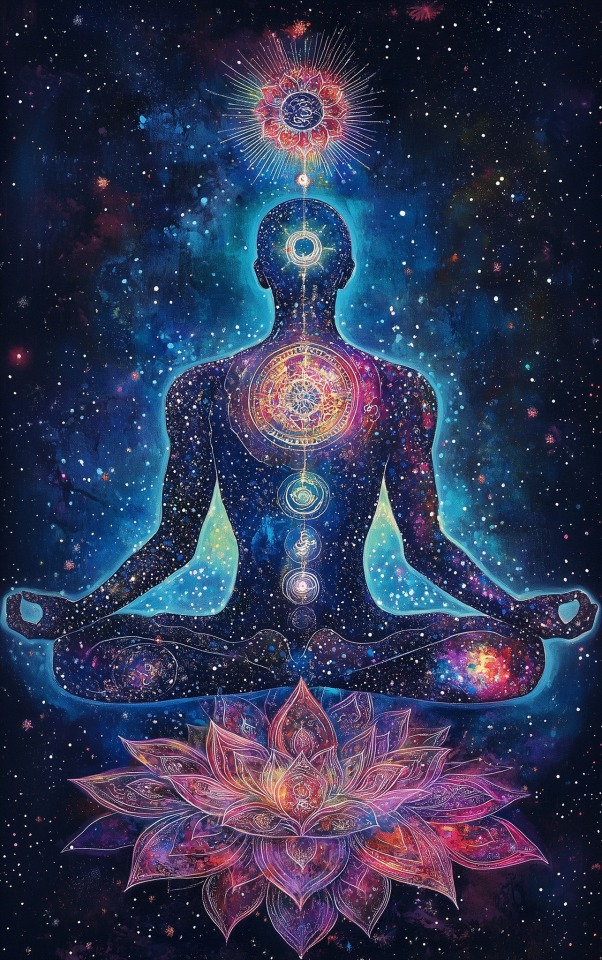
Moksha Talon Abraxas
Moksha is the summum bonum of life. Moksha is the fulfilment of life's purpose. Life ends on this earth plane when you attain Moksha or liberation from birth and death. The realisation of your real object in life is freedom or Moksha. Moksha bestows on you eternal life of undecaying bliss and perennial joy. Moksha is not annihilation. Moksha is the annihilation of this little self-arrogating ego only. Moksha is realisation of the identity of the individual soul with the Supreme Soul. By annihilating this little self you possess the whole of true universality, you attain an eternal life.
Mukti is obtained through the knowledge of the Self. To attain Jnana, you must have one-pointedness of mind (Ekagrata). Ekagrata comes through Upasana. Upasana comes through purity of heart (Chitta Suddhi). Chitta Suddhi comes through Nishkamya Karma Yoga. To do Nishkamya Karma, you must have controlled the Indriyas. The Indriyas can be controlled through Viveka and Vairagya.
Moksha is not to be regarded as a becoming into something which previously had no existence. Moksha is not something to be achieved. It is already achieved. Everything is one with Absolute or Para Brahman. What is to be achieved is annihilation of the sense of separateness. Moksha is the direct perception of that which has existed from eternity, but has hitherto been concealed from us on account of the veil of ignorance. Moksha is attainment of the Supreme Bliss or Immortality and removal of all kinds of pain. Moksha is freedom from birth and death.
Freedom or Mukti is your only real nature. You will have to know this truth only through direct intuitive experience. You will have to cut asunder the veil of ignorance by meditation on the Self. Then you will shine in your original pristine purity and divine glory.
Brahman, Self, Purusha, Chaitanya, Consciousness, God, Atman, Immortality, Freedom, Perfection, Bliss, Bhuma or the unconditioned are synonymous terms. If you attain Self-realisation alone, will you be freed from the round of births and deaths and its concomitant evils. The goal of life is the attainment of the final beatitude or Moksha. Moksha can be attained by constant meditation with a heart that is rendered pure and steady by selfless service and Japa.
Moksha is the highest benefit, Parama Prayojana. Jnana is the benefit which one gets in the internal (Avantara Prayojana). Just as plantain fruit is the highest benefit which one gets, and the leaves, etc., are the Avantara Prayojana in the interval before one gets the fruit, so also Moksha is the highest benefit and Jnana is Avantara Prayojana. Jnana is only the means to attain the highest bliss.
The Jiva falsely superimposes the body and others which are not Self upon himself and identifies himself with them. This identification constitutes bondage. The freedom from this identification is Moksha. That which causes this identification is Avidya or nescience. That which removes the identification is Vidya. Attainment of knowledge of the Self eradicates this Avidya and its effects. The Svaroopa of Moksha is the attainment of Supreme Bliss and removal of all kinds of sufferings.
The right knowledge of Brahman consists in knowing that He is one with one's own self. The difference between the Jiva and the Brahman lies only in the Upadhi or limiting adjunct. The Jiva, though he is Brahman in reality or essence is subject to the miseries of worldly existence as caused by his connection with the Upadhi of Antahkarana or the fourfold mind (the inner instrument). As there is no real distinction between them, it should be known that Brahman is identical with the Self. Hence it is said that those who know the real truth understand Brahman to be identical with the Self as declared in the great sentences of the Upanishads or Mahavakyas: "I am Brahman"-"This Self is Brahman." They even teach the same thing to their disciple in the words: "Tat Tvam Asi-Thou art That." Therefore it should be known that Brahman is identical with the Self.
The knower of Brahman becomes Brahman itself. Having become Brahman while yet alive, he is freed from the round of birth and death. Knowledge of Brahman alone is the means of emancipation or Moksha. by Swami Sivananda
29 notes
·
View notes
Text
The pure Self is not realized unless the mind subsides. The mind is nothing but a bundle of thoughts, and the first and foremost of all thoughts is the primal ‘I’-thought. Therefore, only through the enquiry ‘Who Am I ?’ does the mind subside. To keep the mind constantly turned within and to abide thus in the Self is alone Self -Enquiry.
By steady and continuous investigation into the nature of the mind, the mind is transformed into THAT to which the ‘I’ refers, and that is verily the Self.
That which arises in the physical body as ‘I’, is the mind. If one enquires whence this ‘I’-ness first arises, it will be found that it is the Heart.
Restraint of the outgoing mind and its absorption in the Heart is known as introversion. When the mind becomes absorbed in the Heart, the ‘I’ or ego vanishes, and pure Consciousness or Self, which subsists during all the states of the mind, alone remains resplendent. This state, where there is not the slightest trace of the ‘I’-thought, is one’s true Swarupa ( true nature). And, that is called Quiescence or Mouna; that is also true Wisdom.
The Self alone exists; and the Self alone is real. Verily the Self alone is the world, the ‘ I’ and God. All that exists is but the manifestation of the Supreme Being.
Firm and disciplined inherence in the Self does verily constitute self-surrender to the Supreme Lord. Let any amount of burden be laid on Him, He doth bear it all.
That which is Bliss is verily the Self. Bliss and the Self are one and identical. And, THAT alone is real. Not even in one of the countless objects of the world is there anything that can be called happiness. This phenomenal world is nothing but thought. When the mind is free from thought, it enjoys the Bliss of the Self. The mind of the Enlightened One never exists apart from the Self Absolute.
Likes and dislikes, love and hatred, are equally to be eschewed. It is not proper to let the mind rest often on the objects or affairs of mundane life. If the ego subsides, all else will also subside. The deeper the humility with which we conduct ourselves, the better it is for us. Everything that is offered to others is really an offering to oneself. Not to desire anything extraneous to oneself is Vairaghya or Dispassion. Not to give up one’s hold on the Self is Jnana or Enlightenment. Thus, Vairaghya and Jnana are really one and the same.
Pledged to Vairaghya, every aspirant must dive deep into himself and realize the precious Atman, the Self Absolute.
God and Guru are one. He that has earned the Grace of the Guru shall undoubtedly be saved and never forsaken. But, the disciple, for his part, should follow the path shown by the Master.
Excepts from Sri Bhagavan’s ‘WHO AM I ?
14 notes
·
View notes
Note
Hii, how's everything going?
I had a question about what if the freedom I feel is only 10% of my time and the peace/indifference internally seems to be also momentary (more than 10% I'd say, still not "satisfying") will this freedom and indifference become my norm if I keep practicing this?
At some times it's easy, and I will actually feel this great feeling of peace and solace but they really are very minimal. Some other times it feels like I'm at a fight with this mind, a fight I know grows through my efforts to end it but it all will seem so hard at that time. It feels often like I'm only hiding and fearful of the ego and the mind.
Also, another thing but lately I've been fearful towards an event that my mind says might occur. I decided then that it may happen then its not happening to me, it's happening to the character I'm playing. Still, I don't even want it to happen to the character I'm playing. This would be unnecessary and I think the idea of "it will happen to the character I'm playing and not my true self" Sometimes makes me think that I'm this way leading to it occurring to my character since some people imagine the ego with the desire the ego has, so the desire actually occurs to this ego/character/materialises before the senses. I could use a little help with how I should deal with this?
AND I'm hoping you're having very peaceful great days!! You're very kind 💌🫶
will this freedom and indifference become my norm if I keep practicing this?
Depends what you're practicing, you haven't mentioned it anywhere.
Some other times it feels like I'm at a fight with this mind, a fight I know grows through my efforts to end it but it all will seem so hard at that time. It feels often like I'm only hiding and fearful of the ego and the mind.
Mind purification is necessary for the restless mind, read this and this. You can do this through releasing or any other sadhana (spiritual practice), whatever works for you.
New age teachers and "non teachers" seem to ignore that they speak to people whose minds are filled with rajas (restlessness) and tamas (inertia), clinging mainly to sensual life and who are, perhaps, at the beginning of spirituality (even if they are engaged in spiritual practices for many years). But Vedanta is for people endowed with dispassion, discrimination and self control. Rajasic and tamasic minds are always agitated, anxious, desirous, distracted, fearful, extroverted, etc. How is it possible for an impure mind full of rajas and tamas to do contemplation, meditation and Self-enquiry? How is it possible for an impure mind to comprehend the principles of Vedanta and put them into practice? How is it possible for an impure mind, which most of the time is dwelling on sense objects and can only perceive gross forms, to realize the Atman which is the essence of life and the subtlest of all? The fact is that only when the mind is purified to a great extent, it becomes our friend and a great instrument for Self-enquiry and meditation. Then Self-realization is very easy. New age teachers and "non teachers" used to say: "You are already That"; "Who is going to do sadhana or spiritual practices?"; "Just be here now." These sayings may seem wonderful for tamasic-rajasic minds! But it is not easy for someone to still the mind and "be". Talks cannot destroy ignorance, vasanas and samskaras that are accumulated from many past births. Only intense uninterrupted sadhana can make the mind one-pointed and still. They claim also that spiritual practices strengthen the ego and sadhana becomes a prison for the seeker. How can that be so? They really don't know, probably because they never did real sadhana. Great masters like Jesus Christ, immortal Babaji, Satya Sai Baba, Swami Sivananda, Vedanta teachers like Adi Shankaracharya, Sri Ramana Maharshi and scriptures like the Upanishads, the Bhaghavad Gita, etc., tell us to purify our minds and hearts through sadhana. If sadhana and the purification of mind are not necessary, it means that the sayings of the great masters are false. New age teachers say that everything is illusory, just a dream, that everything just happens. Then who is going to do what? Surely everything is an illusory appearance, a long dream. But only for those who have awakened from the dream! For the rest, it is a very solid reality.
This world is an illusory reflection of Consciousness; jiva is illusory, bondage and liberation are also illusory. But this is very easily misunderstood. The bondage is illusory, but this does not mean that sadhana is not necessary. When someone is hungry or thirsty, he has to eat or drink something to relieve his hunger or thirst. In this illusory world, an illusory hunger can be satisfied by illusory food! Similarly, illusory bondage can be destroyed by an illusory sadhana. The illusory practices can destroy all the fancies of the mind at its root (ignorance and ego). This is impossible without practice. Only in very rare cases like Sri Ramana Maharshi can this happen instantly. But that happened because he did intense sadhana in many previous lives. You have to practise constantly with faith, steady determination and perseverance to purify your mind and heart. Simultaneously practise meditation and Self-enquiry to realize your true nature. You have to practise until the mind is empty from desires, attachments, egoism, all samskaras and vasanas, until you are established effortlessly in your true nature. As Ramana Maharshi has said "There is a state beyond our efforts or effortlessness. Until that is realized, effort is necessary. Intense effort is necessary until the I-thought disappears completely in the heart (Self)" Do real sadhana my dear children, do real sadhana. You cannot wake up from the dream of separation only by talking and listening. Do intense sadhana from this very moment to realize your divine nature. Time passes by very fast. Tomorrow will never come. Every day there is a tomorrow. Do not waste your time in trifling illusory sense pleasures. Live every moment of your life for Self-realization. Put Vedanta into practice. Destroy 'I-ness' and 'mine' that separate you from God and the world. Realize your real Self in this very life. Be an embodiment of peace, love and harmony. This is your birthright and the purpose you took for this human body.
Also, another thing but lately I've been fearful towards an event that my mind says might occur. I decided then that it may happen then its not happening to me, it's happening to the character I'm playing. Still, I don't even want it to happen to the character I'm playing.
First, I recommend using this practice to bring up the fear and let the feelings be released while you observe and remember it's only a feeling, you're not going to die from it. The more you try to fight/ignore/resist it, the more it persists. Let it come up, let it be and it will dissolve. Keep doing it until it's all gone. After you've done this, if there still remains any fear, go within and find out why you have this fear about this event occurring. Get to the root causative thought/beliefs and then drop them.
After this, if it resonates, you can do a practice where you allow yourself to feel safe and know that you are safe (you can think of it as giving yourself safety and security if it helps). You can do it however it feels good to you: imagination, thoughts, affirmations, meditation - whatever feels good. The reason I suggest this is because it seems this fear is rooted in a fear for survival and a perceived lack of safety and security. So see yourself having safety and security. Do it for as long as you want until you feel okay. (If there are other root senses of lack other than lack of safety and security from your fear, then give yourself whatever it is you think you lack)


53 notes
·
View notes
Text
Comforting the Ego Through Self-Inquiry: A Gentle Path into the Mystic
The Tibetan teaching that the ego is a belief in a separate self with no inherent existence aligns perfectly with the process of self-inquiry. As we engage in the practice, the recognition that the ego has no independent reality allows it to gradually dissolve. What remains is the awareness that transcends the illusion of separation—the true nature of the Self. For many years, I’ve engaged in…
#Advaita Vedanta#Atman#awakening#Brahman#compassion for the ego#consciousness#ego and mind#ego dissolution#Inner peace#meditative practices#Mindfulness#Mysticism#non-duality#pristine mind#Self-awareness#self-compassion#self-inquiry#Self-Realization#spiritual awareness#spiritual growth#Spiritual Practice#stillness#Tat Tvam Asi#Tibetan teachings#Upanishads#who am I practice#Witness Consciousness
4 notes
·
View notes
Text
How do I live as love in each moment?
By bowing to the divine in all I meet,
by seeing the atman shining through their eyes,
by offering without thought of return,
and receiving with the same grace.
I live as love by surrendering the ego,
the small “I” that clings to pride and fear.
I step into the flow of dharma,
walking the path of seva,
serving the world as if it were my very soul.
To live as love is to see the dance,
to honor both Shiva’s destruction
and Vishnu’s preservation,
to embrace the fleeting forms of maya
as expressions of the infinite.
It is to breathe deeply into the moment,
to hear the hum of Om in the silence,
to recognize that the heart of another
is not separate from my own.
I live as love when I dissolve the barriers,
when the “I” and “you” fade like shadows at sunrise.
In that light, love is not something I do—
it is who I am.
11 notes
·
View notes
Text
Mundane Design Detail of Digital Devil Saga: Tag Rings
(Spoilers for both DDS + DDS2.)
I have a tendency to look way too deep into little details of character designs in media, and when it comes to DDS where uniform designs are common, it gets even more fun for me. One of the things that first stood out was tag rings; the Junkyard invention that is introduced briefly and very early in the game as identifiable objects used simultaneously as trackers for downloadable mantras and can also act as digital wallets. I always wondered though, how much more they can represent for a character's actual design rather than just being a game tool for logging progress.

Rings on different fingers (and hands) represent different ideas on how we wish to present ourselves; these ideas can change from culture to culture, and in observing these differences, I looked both at general Western culture and of course, Hinduism. I was able to find more information in Western cultures with more commonalities. However, in Hinduism, by looking into mudras, you'll find rings on each finger can still hold different meanings. The middle finger is "ego", the pinky is "illusion", the ring finger is "karma". The index finger is Jiva-Atman - the individual soul or self. The thumb is Paramatman - the universal, eternal soul.
And if you've noticed, most individuals of the Junkyard wear their tag rings on their middle finger (on their left hand). In Western culture, the middle finger, similar to "ego" in Hinduism, represents "individuality". And hey, what do you know? That's a pretty important theme brought up later on.
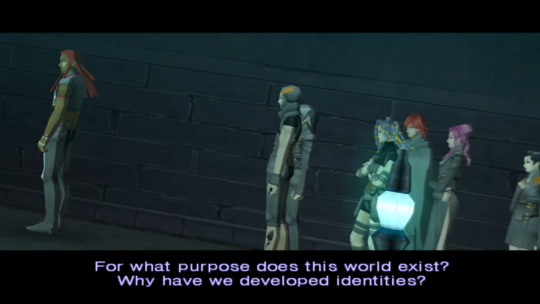
The Samsara Tunnels scene with Lupa is actually what drove me to research further into this. Lupa removes his tag ring before performing an inevitable act of self-sacrifice, and at first, I thought it meant he was giving up his individuality. Until I noticed that no, Lupa wears his ring on his index finger on his right hand, rather than his middle finger on his left hand like almost everyone else. In Western culture, the index finger on the right hand instead represents the "potential for leadership". Fitting, for the Leader of the Wolves, who has offered his own head to the dominating tribe of the Embryon.
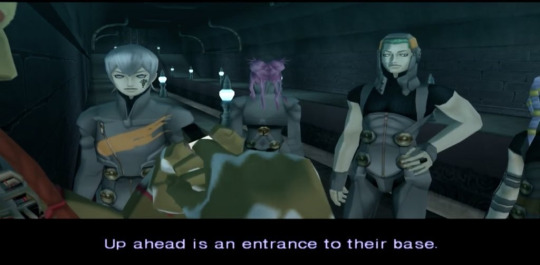
And then he hands it to Gale - who slips it onto his left hand next to his other ring, and he puts it on his index. And what does that represent? Comradery. Ohhhhhhhhh man. Let's go, gay subtext!!!

Irrelevant comment: (The funny thing is Lupa's ring literally does not pop up on his hand until the camera focuses on his hand and then it disappears. For the rest of the scene and the rest of the game and DDS2 it is gone. I don't know if that was an intentional choice - I doubt it - perhaps the animators didn't want to make a whole other Gale model with the two rings. I like to think he kept the ring...)
Moving onto DDS2, and Serph sells his tag ring at the Mad Mart to make some cash. Nobody else sells their rings. With the hacking disk, they are no longer needed, so it seems everyone just keeps it for sentiments. Serph himself also wears his ring on his middle finger, so was it a story choice for him to give it away - to represent him giving up his individuality? Of course, maybe not immediately, but eventually, Serph's individuality blends with another soul - being Sera's - in order to become Seraph. And no, they do not wear any rings, because neither Sera nor Serph did at the point of fusing.
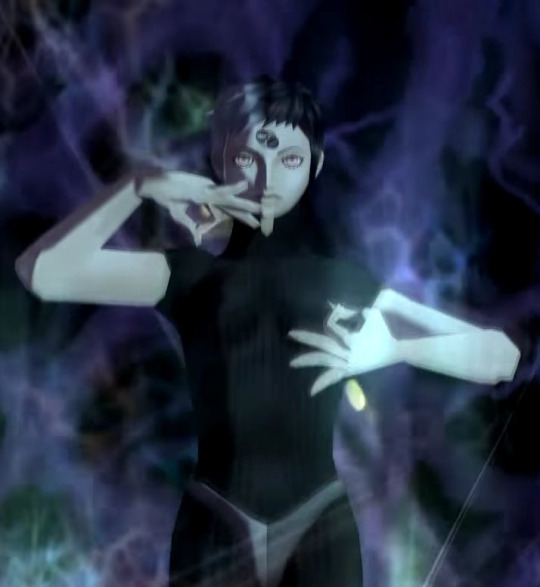
Yeah.
Some additional points:
Cielo doesn't wear his tag ring as a ring, he wears it as a necklace. Similar to Lupa and his layers of necklaces with several tag rings. I'm not sure what that means - usually, necklaces with rings represent vows, most commonly found for promise rings. They can also represent deceased loved ones. Which is quite heartbreaking when you think about Lupa's necklaces...
Generally, the right hand for rings is the "action" hand while the left is the "thinking" hand.
If I ever find more information and more opportunities to extend this drabble, I will. I'm not sure how interesting this essay is for others, but some friends were interested in hearing it. I really do wonder how much thought was put into this design aspect, and if anyone has their own knowledge to bring to the table, I'd love to hear it.
113 notes
·
View notes
Text
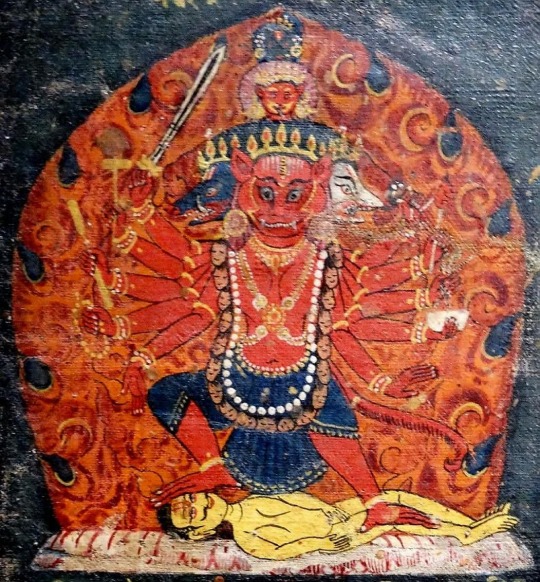
"Trika is a consistent monistic system. The three aspects of reality it identifies: unity (abheda), unity prevailing over differentiation ( bheda-abheda ) and differentiation (bheda ) are subordinated to the monistic vision.
world. It is impossible to say definitely about the Absolute , Paramashiva (Supreme Shiva), who contains all three aspects, even that he is the One, since he, surpassing even unity, constitutes the All, and nothing exists apart from him.
The Absolute is the eternal consciousness of itself (chaitanya), the identity of the Self ( Atman ), Consciousness ( chit ) and the "I" (aham).
Atman is not a subject opposed to an object, but the absolute Subject, the perfect unity of subject and object, alien to all conditioning, since, from the point of view of the Kashmir Shaivites, there is nothing other than the conscious Self, which contains everything that is.
The reality of Consciousness cannot be questioned, since it reveals (illumines) itself (svaprakasha) and is thus self-validating: without this light of the Supreme Consciousness, the individual soul, the ego, could not be aware of its own existence. Consciousness is not only light (prakasha), but the act of becoming aware of this light (vimarsha), an expression of the freedom of action of consciousness (svatantra), which consists in its capacity for constant actualization.
Consciousness coincides with itself in each of its free acts, vimarsha and prakasha constitute two aspects, two poles of the oscillation of consciousness, creating vibration ( spanda ), and this vibration itself is the main source of energy that maintains the existence of the Universe.
In spite of the distinction between consciousness and self-consciousness, that is, between prakasha and vimarsha, which is conventional and is made only in order to facilitate the understanding of two aspects of a single entity, the universal Consciousness remains undivided."
5 notes
·
View notes
Text
The Philosophy of Advaita Vedanta
Advaita Vedanta is a non-dualistic school of Hindu philosophy that teaches that the ultimate reality, Brahman, is singular and that the individual self, Atman, is not separate from this ultimate reality. "Advaita" literally means "not two," indicating the core idea that Atman and Brahman are one and the same, and that any perception of duality (between self and world, subject and object) is an illusion.
Key Principles of Advaita Vedanta
Non-Duality (Advaita):
The central tenet of Advaita Vedanta is that there is only one ultimate reality, Brahman, which is infinite, formless, and beyond all distinctions. The apparent multiplicity of the world and separate selves (Atman) is considered Maya (illusion).
Atman (the individual self) is identical to Brahman. The idea that we are separate individuals with independent identities is an illusion caused by ignorance (Avidya).
Brahman:
Brahman is the universal, unchanging, infinite reality that underlies all existence. It is beyond time, space, and causality, and is the only true essence of everything.
Brahman is often described as Nirguna Brahman (Brahman without attributes), meaning it is formless, indescribable, and transcendent, but it can also be understood as Saguna Brahman (Brahman with attributes) when conceptualized as a personal God with qualities for devotional purposes.
Atman:
Atman refers to the inner self or soul, which is eternal and identical with Brahman. In Advaita Vedanta, realizing that one's true self (Atman) is Brahman is the goal of spiritual practice.
The ignorance (Avidya) of this fundamental identity between Atman and Brahman is what causes Samsara (the cycle of birth, death, and rebirth) and suffering.
Maya (Illusion):
The world of appearance, multiplicity, and individuality is called Maya. Maya is responsible for creating the illusion of separation and duality.
While the world appears real on a practical level (Vyavaharika), it is ultimately unreal on the absolute level (Paramarthika). Realizing the nature of Maya helps one see beyond the illusion to the true oneness of reality.
Avidya (Ignorance):
Avidya is the root cause of the human experience of duality and separation. It is the ignorance of the true nature of the self, leading to the mistaken belief in the individuality of the self (ego) and the reality of the material world.
Liberation, or Moksha, is attained through the removal of Avidya and the realization of one’s identity with Brahman.
Jnana Yoga (Path of Knowledge):
The primary method to attain liberation in Advaita Vedanta is Jnana Yoga, or the path of knowledge. This involves deep philosophical inquiry and meditation on the nature of the self, using teachings like "Tat Tvam Asi" ("You are That"), which emphasizes the unity of Atman and Brahman.
The study of Upanishads, Bhagavad Gita, and other scriptural texts is central to the pursuit of Jnana.
Liberation (Moksha):
Moksha is the realization of the oneness of Atman and Brahman, which frees one from the cycle of Samsara. It is the ultimate goal of human existence in Advaita Vedanta.
This liberation is not about going somewhere else or achieving something new, but about realizing what has always been true: that one's true nature is already infinite, eternal, and beyond duality.
Guru and Shravana, Manana, Nididhyasana:
A guru (spiritual teacher) plays a crucial role in guiding a disciple toward the realization of non-duality.
The traditional method of learning in Advaita Vedanta includes:
Shravana: Listening to the teachings of the scriptures.
Manana: Reflecting upon those teachings.
Nididhyasana: Deep meditation on the truth of the teachings, leading to the experiential realization of non-duality.
Advaita Vedanta and Other Philosophical Systems
Dvaita (Dualism): In contrast to Advaita's non-dualism, Dvaita Vedanta holds that the individual self (Atman) and the supreme being (Brahman) are eternally distinct. Dualistic schools argue for a personal relationship with God and a clear distinction between creator and creation.
Visishtadvaita (Qualified Non-Dualism): This school also sees unity in the universe but believes that individual souls and the material world are real parts of Brahman, distinct yet inseparably connected.
Buddhism: Although there are some similarities between Advaita Vedanta and Mahayana Buddhism (e.g., the idea of emptiness and the illusion of separateness), Buddhism rejects the concept of an eternal, unchanging self (Atman), which Advaita Vedanta upholds.
Advaita Vedanta is a profound philosophical system that focuses on realizing the ultimate oneness of all reality, transcending the illusion of duality. Through spiritual knowledge, self-inquiry, and meditation, one can awaken to the truth that the individual self (Atman) and the universal consciousness (Brahman) are not separate, leading to liberation from the cycle of birth and death.
#philosophy#epistemology#knowledge#learning#education#chatgpt#ontology#metaphysics#Advaita Vedanta#Non-Duality#Brahman and Atman#Maya and Avidya#Jnana Yoga#Moksha#Hindu Philosophy#Oneness of Reality#Self-Realization#Upanishads
8 notes
·
View notes
Text
In the ancient Indian Upanishads, the answer to the question “Who am I?” is “Tat tvam asi.” This succinct Sanskrit sentence means literally: “Thou art That,” or “You are Godhead.” It suggests that we are not namarupa—name and form (body/ego), but that our deepest identity is with a divine spark in our innermost being (Atman) that is ultimately identical with the supreme universal principle (Brahman). And Hinduism is not the only religion that has made this discovery. The revelation concerning the identity of the individual with the divine is the ultimate secret that lies at the mystical core of all great spiritual traditions. The name for this principle could thus be the Tao, Buddha, Cosmic Christ, Allah, Great Spirit, Sila, and many others.
— Stanislav Grof, Holotropic Breathwork (Suny Series in Transpersonal and Humanistic Psychology)
10 notes
·
View notes
Text
Summer Solstice
June 21st traditionally marks the Summer Solstice - the moment when the Sun reaches its northernmost point in the sky. It is the longest day of the year in the Northern Hemisphere, a powerful astronomical event that also carries deep spiritual significance.
In the traditions of Sanatana Dharma and Jyotish Shastra (Vedic astrology), the days around the Summer Solstice are infused with intensified solar energy, symbolising clarity, consciousness, and transformation. It is a sacred window of time - ideal for setting intentions, deepening spiritual practices, and aligning with the rhythms of the cosmos.
Spiritual significance of Summer Solstice
In Vedic astrology, the Sun represents the Atman (the soul), ego, truth, consciousness, and divine will. At the solstice, when the Sun is at its peak, its influence on the mind, body, and spirit is magnified. This is a gateway to:
Inner purification
Heightened awareness
Spiritual insight and breakthroughs
Ancient yogis revered this time for tapasya (austerity), meditation, pranayama, and rituals that harmonise individual will with cosmic order.
Practices to embrace during this time
Wake up before sunrise and receive the first light - Sun rays are potent for vitality and mental clarity
Set intentions for your long-term goals, dreams, and soul purpose
Begin or deepen spiritual practices such as mantra japa, meditation, or breathwork
Reflect on your personal dharma (your righteous path): What must be illuminated? What shadows are ready to be released?
Transition from Uttarayana to Dakshinayana
Since ancient times, Vedic sages divided the year into 2 sacred halves:
Uttarayana – the bright half, from Winter Solstice to Summer Solstice
Dakshinayana – the dark half, from Summer Solstice to Winter Solstice
As of yesterday, we have entered Dakshinayana, marking the Sun's southward journey - a symbolic shift from outer expansion to inner reflection. This phase invites us to harvest the fruits of what we have cultivated during the bright half of the year.
Words from Mahabharata*
"Those who depart the body during Uttarayana go toward the light. Those who pass during Dakshinayana undergo a journey of cleansing."
This teaching underscores the spiritual character of this transition. The energetic rhythm of the year changes now—and with it, we are called to turn inward, to nourish the inner flame even as the outer light begins to wane.
Happy Midsummer!
Use solar energy to make your deepest dreams come true. Even small acts of alignment with nature, like walking under the morning sun or practicing silence, can help you tune into this powerful solar period.
* Mahabharata - one of the greatest epic texts of Ancient India

8 notes
·
View notes